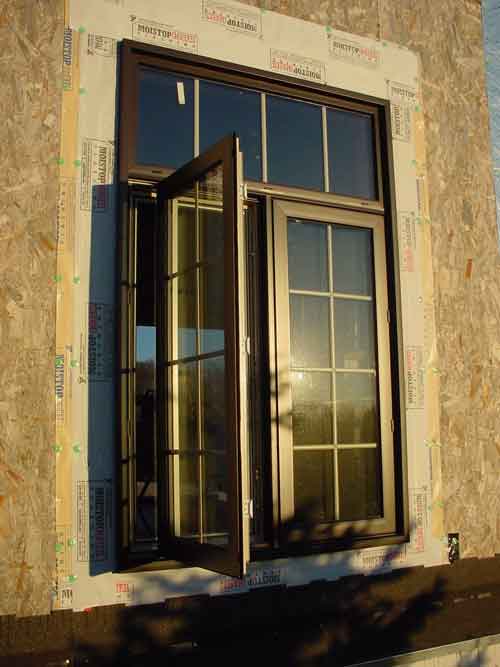Crucial Issue#1: Glazing Features That Matter
Of all the tricks engineers use to overcome the fact that glass is a poor insulator, smart low-e coatings may be the most interesting. They’re like a one-way door for trapping and holding energy
 The letter “e” in this case stands for emissivity – a thermodynamic term that refers to the tendency for a material to radiate energy away from itself. Older style, low-e coatings did prevent energy from radiating outwards during winter nights, but they also reduced solar energy gain during the day. The latest low-e systems, however, allow the sun to warm buildings while also reducing heat loss. Think of them like an energy turnstile. Heat goes in more easily than it comes back out.
The letter “e” in this case stands for emissivity – a thermodynamic term that refers to the tendency for a material to radiate energy away from itself. Older style, low-e coatings did prevent energy from radiating outwards during winter nights, but they also reduced solar energy gain during the day. The latest low-e systems, however, allow the sun to warm buildings while also reducing heat loss. Think of them like an energy turnstile. Heat goes in more easily than it comes back out.
So what about triple glazing? Is it worth it? The short answer is yes, and the best way to justify this is by pointing towards trends.
Triple glazing was originally available only in the coldest areas of Canada – the prairie provinces and the far north – but that’s changing, and for good reason. As government-sponsored energy performance standards rise, triple glazing is becoming more and more popular. But besides energy savings, triple glazing also offers a valuable benefit that few people understand.
The insulating value of most Canadian windows is low enough that glass surfaces readily form condensation during cold weather. In fact, if a homeowner lowers indoor humidity levels to the point where window condensation does not occur during the coldest winter weather, many people find the air much too dry for comfort. And If those same clients turn up the dial on their humidifier and window condensation occurs, the mold and mess that results is going to look terrible.
Anything that improves the insulation value of the glass surface will keep the interior surface of the glass warmer at a given outdoor temperature level, making it correspondingly less likely to form condensation. Triple glazing goes a long way to prevent window condensation at indoor humidity levels that don’t dry you up like a prune.
For similar reasons, look at windows with plastic separating the panes of glass, not metal. Generically called warm edge glazing, plastic systems offer much better insulation performance, reducing the tendency for window condensation even more.
Crucial Issue#2: Assess Performance By the Book
There are thousands of windows on the market, and it’s difficult to understand the scientific tools that are available to assess individual window performance. One reason for this is complication. Over the years there’s been a  hodgepodge of systems for assessing the energy performance of windows, but things are getting simpler. Something called Energy Rating analysis (ER) is one reason why.
hodgepodge of systems for assessing the energy performance of windows, but things are getting simpler. Something called Energy Rating analysis (ER) is one reason why.
It’s a system for rating the energy efficiency of windows, sliding doors and insulated steel doors. The ER number is based on measurements of solar heat gain, heat loss through frames and at the center and the edges of glass. Heat loss through air leakage is also part of the mix. Top rated windows, for instance, can earn an ER number in the high 30s.
Another independent yardstick of performance that you should know about is the CSA A440 rating. Created by the Canadian Standards Association, it addresses a wider range of parameters than ER scores alone.
The easiest place to find a listing of Canadian window manufacturers that build products certified to the CSA A440 standard is at www.WindowWise.com. Just be careful. Not all windows made by a specific manufacturer necessarily meet the CSA A440 requirements.
Crucial Issue#3: Enhanced Installation Techniques
There’s growing concern that current building code standards aren’t sufficient to handle the increasing risk posed by more destructive weather patterns were seeing all over the world. So-called “disaster resistant” homes built to higher standards include upgraded window installation features that keep water out better in two ways.
One involves the use of synthetic, self sticking window flashing products. These lap behind and over top of window frames, sealing out wind driven water better than the traditional hope, pray and tape method. And in the event that water does get past the flashing, it pays to install window and door pan systems. Now made by a handful of companies (Google “window pans” to find them), these preformed, sloped plastic liners direct water leaks back outside, keeping framing members and insulation dry. A few hundred dollars in supplies and you may avert the development of mold in internal wall cavities.
It doesn’t take much information to steer your way through the maze of window and door complication. It’s just another example of how a little knowledge can make all the difference.



